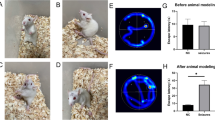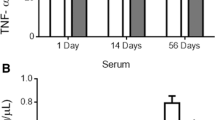Abstract
Zinc transporter 3 (ZnT3)-dependent “zincergic” vesicular zinc accounts for approximately 20% of the total zinc content of the mammalian telencephalon. Elevated hippocampal ZnT3 expression is acknowledged to be associated with mossy fiber sprouting and cognitive deficits. However, no studies have compared the long-term neurobehavioral phenotype with the expression of ZnT3 in the cerebral cortex following status epilepticus (SE). The aim of this study was to investigate changes in the long-term neurobehavioral phenotype as well as the expression of ZnT3 and calcium homeostasis-related CB-D28k in the cerebral cortex of rats subjected to neonatal SE and to determine the effects of leptin treatment immediately after neonatal SE. Fifty Sprague-Dawley rats (postnatal day 6, P6) were randomly assigned to two groups: the pilocarpine hydrochloride-induced status epilepticus group (RS, n = 30) and control group (n = 20). Rats were further divided into the control group without leptin (Control), control-plus-leptin treatment group (Leptin), RS group without leptin treatment (RS), and RS-plus-leptin treatment group (RS + Leptin). On P6, all rats in the RS group and RS + Leptin group were injected intraperitoneally (i.p.) with lithium chloride (5 mEq/kg). Pilocarpine (320 mg/kg, i.p.) was administered 30 min after the scopolamine methyl chloride (1 mg/kg) injection on P7. From P8 to P14, animals of the Leptin group and RS + Leptin group were given leptin (4 mg/kg/day, i.p.). The neurological behavioral parameters (negative geotaxis reaction reflex, righting reflex, cliff avoidance reflex, forelimb suspension reflex, and open field test) were observed from P23 to P30. The protein levels of ZnT3 and CB-D28k in the cerebral cortex were detected subsequently by the western blot method. Pilocarpine-treated neonatal rats showed long-term abnormal neurobehavioral parameters. In parallel, there was a significantly downregulated protein level of CB-D28k and upregulated protein level of ZnT3 in the cerebral cortex of the RS group. Leptin treatment soon after epilepticus for 7 consecutive days counteracted these abnormal changes. Taken together with the results from our previous reports on another neonatal seizure model, which showed a significant positive inter-relationship between ZnT3 and calcium/calmodulin-dependent protein kinase IIα (CaMKIIα), the data here suggest that ZnT3/CB-D28k–associated Zn (2+)/Ca(2+) signaling might be involved in neonatal SE-induced long-term brain damage in the aspects of neurobehavioral impairment. Moreover, consecutive leptin treatment is effect at counteracting these hyperexcitability-related changes, suggesting a potential clinical significance.




Similar content being viewed by others
References
McGee SL, Sadli N, Morrison S et al (2011) DHA protects against zinc mediated alterations in neuronal cellular bioenergetics. Cell Physiol Biochem 28:157–162
McCord MC, Aizenman E (2013) Convergent Ca2+ and Zn2+ signaling regulates apoptotic Kv2.1 K+ currents. Proc Natl Acad Sci U S A 110:13988–13993
Mortadza SS, Sim JA, Stacey M, Jiang LH (2017) Signalling mechanisms mediating Zn2+-induced TRPM2 channel activation and cell death in microglial cells. Sci Rep 7:45032
Medvedeva YV, Lin B, Shuttleworth CW, Weiss JH (2009) Intracellular Zn2+ accumulation contributes to synaptic failure, mitochondrial depolarization, and cell death in an acute slice oxygen-glucose deprivation model of ischemia. J Neurosci 29:1105–1114
Clausen A, McClanahan T, Ji SG, Weiss JH (2013) Mechanisms of rapid reactive oxygen species generation in response to cytosolic Ca2+ or Zn2+ loads in cortical neurons. PLoS One 8:e83347
Vander Jagt TA, Connor JA, Shuttleworth CW (2008) Localized loss of Ca2+ homeostasis in neuronal dendrites is a downstream consequence of metabolic compromise during extended NMDA exposures. J Neurosci 28:5029–5039
Ni H (2016) Zinc/cPLA2 associated autophagy and CaMK II pathway contributed to neurobehavioral deficits and hippocampal MFs sprouting following neonatal seizures and its intervention by chronic leptin treatment. J Neonatal Biol 5(4(Suppl)). https://doi.org/10.4172/2167-0897.C1.002
Morrison CD (2009) Leptin signaling in brain: a link between nutrition and cognition? Biochim Biophys Acta 1792:401–408
Munzberg H, Morrison CD (2015) Structure, production and signaling of leptin. Metabolism 64:13–23
Harvey J (2007) Leptin: a diverse regulator of neuronal function. J Neurochem 100:307–313
Shanley LJ, O'Malley D, Irving AJ, Ashford ML, Harvey J (2002) Leptin inhibits epileptiform-like activity in rat hippocampal neurones via PI 3-kinase- driven activation of BK channels. J Physiol 545:933–944
Doherty GH, Beccano-Kelly D, Yan SD (2013) Leptin prevents hippocampal synaptic disruption and neuronal cell death induced by amyloid beta. Neurobiol Aging 34:226–237
Geiger JR, Melcher T, Koh DS et al (1995) Relative abundance of subunit mRNAs determines gating and Ca2+ permeability of AMPA receptors in principal neurons and interneurons in rat CNS. Neuron 15:193–204
Obeid M, Frank J, Medina M, Finckbone VL, Bliss R, Bista B, Majmudar S, Hurst D, Strahlendorf H, Strahlendorf J (2010) Neuroprotective effects of leptin following kainic acid-induced status epilepticus. Epilepsy Behav 19:278–283
Walker CD, Long H, Williams S, Richard D (2007) Long-lasting effects of elevated neonatal leptin on rat hippocampal function, synaptic proteins and NMDA receptor subunits. J Neurosci Res 85(4):816–828
Torolira D, Suchomelova L, Wasterlain CG (2016) Widespread neuronal injury in a model of cholinergic status epilepticus in postnatal day 7 rat pups. Epilepsy Res 120:47–54
Hirsch E, Baram TZ, Snead OC 3rd (1992) Ontogenic study of lithium-pilocarpine-induced status epilepticus in rats. Brain Res 583(1–2):120–126
Raffo E, de Vasconcelos AP, Boehrer A, Desor D, Nehlig A (2009) Neurobehavioral maturation of offspring from epileptic dams: study in the rat lithium-pilocarpine model. Exp Neurol 219:414–423
Rothstein S, Simkins T, Nuñez JL (2008) Response to neonatal anesthesia: effect of sex on anatomical and behavioral outcome. Neuroscience 152:959–969
de Araújo DP, De Sousa CN, Araújo PV et al (2013) Behavioral and neurochemical effects of alpha-lipoic acid in the model of Parkinson’s disease induced by unilateral stereotaxic injection of 6-ohda in rat. Evid Based Complement Alternat Med 2013:571378
Tian T, Ni H, Sun BL (2015) Neurobehavioral deficits in a rat model of recurrent neonatal seizures are prevented by a ketogenic diet and correlate with hippocampal zinc/lipid transporter signals. Biol Trace Elem Res 167:251–258
Honchar MP, Olney JW, Sherman WR (1983) Systemic cholinergic agents induce seizures and brain damage in lithium-treated rats. Science 220(4594):323–325
Shokri S, Kazemi M, Firouzjaei MA, Hemadi M, Moayeri A, Ganjkhani M, Nejatbakhsh R (2015) Melatonin protects testes against lithium-pilocarpine-induced temporal lobe epilepsy in rats: a time course study. Andrologia 47(3):343–353
Erbayat-Altay E, Yamada KA, Wong M, Thio LL (2008) Increased severity of pentylenetetrazol induced seizures in leptin deficient ob/ob mice. Neurosci Lett 433:82–86
Jayaram B, Khan RS, Kastin AJ, Hsuchou H, Wu X, Pan W (2013) Protective role of astrocyticleptin signaling against excitotoxicity. J Mol Neurosci 49:523–530
Mela V, Diaz F, Borcel E et al (2015) Long term hippocampal and cortical changes induced by maternal deprivation and neonatal leptin treatment in male and female rats. PLoS One 10:e0137283
Platt TL, Beckett TL, Kohler K, Niedowicz DM, Murphy MP (2016) Obesity, diabetes, and leptin resistance promote tau pathology in a mouse model of disease. Neuroscience 315:162–174
Lopez-Rodriguez AB, Mela V, Acaz-Fonseca E, Garcia-Segura LM, Viveros MP (2016) CB2 cannabinoid receptor is involved in the anti-inflammatory effects of leptin in a model of traumatic brain injury. Exp Neurol 279:274–282
Li ZH, Li LL, Jin MF, Chen XQ, Sun Q, Ni H (2017) Dysregulation of zinc/lipid metabolism-associated genes in the rat hippocampus and cerebral cortex in early adulthood following recurrent neonatal seizures. Mol Med Rep 16:4701–4709
Tian T, Li LL, Zhang SQ, Ni H (2016) Long-term effects of ketogenic diet on subsequent seizure-induced brain injury during early adulthood: relationship of seizure thresholds to zinc transporter-related gene expressions. Biol Trace Elem Res 174:369–376
Vergnano AM, Rebola N, Savtchenko LP, Pinheiro PS, Casado M, Kieffer BL, Rusakov DA, Mulle C, Paoletti P (2014) Zinc dynamics and action at excitatory synapses. Neuron 82:1101–1114
Nakashima AS, Dyck RH (2009) Zinc and cortical plasticity. Brain Res Rev 59:347–373
Cole TB, Wenzel HJ, Kafer KE, Schwartzkroin PA, Palmiter RD (1999) Elimination of zinc from synaptic vesicles in the intact mouse brain by disruption of the ZnT3 gene. Proc Natl Acad Sci U S A 96:1716–1721
Martel G, Hevi C, Friebely O, Baybutt T, Shumyatsky GP (2010) Zinc transporter 3 is involved in learned fear and extinction, but not in innate fear. Learn Mem 17:582–590
McAllister BB, Dyck RH (2017) Zinc transporter 3 (ZnT3) and vesicular zinc in central nervous system function. Neurosci Biobehav Rev 80:329–350
Girard F, Venail J, Schwaller B, Celio MR (2015) The EF-hand Ca(2+)-binding protein super-family: a genome-wide analysis of gene expression patterns in the adult mouse brain. Neuroscience 294:116–155
Mello LE, Cavalheiro EA, Tan AM et al (1992) Circuit mechanisms of seizures in the pilocarpine model of chronic epilepsy: cell loss and mossy fiber sprouting. Epilepsia 34:985–995
Cho I, Cho YJ, Kim HW, Heo K, Lee BI, Kim WJ (2014) Effect of androsterone after pilocarpine- induced status epilepticus in mice. J Epilepsy Res 4:7–13
Murayama N, Noshita T, Ogino R, Masuda T, Kadoshima T, Oka T, Ueno N, Takemoto N, Toba T, Ueno S, Schulze W, Igawa Y, Morita Y, Inoue T (2015) SUN11602-induced hyperexpression of calbindin D-28k is pivotal for the survival of hippocampal neurons under neurotoxic conditions. Brain Res 1594:71–81
Funding
This work was supported by the National Natural Science Foundation of China (81471337, 81271458), Jiangsu Province’s key medical personnel project (ZDRCC2016008).
Author information
Authors and Affiliations
Corresponding author
Rights and permissions
About this article
Cite this article
Ni, H., Chen, Sh., Li, Ll. et al. Alterations in the Neurobehavioral Phenotype and ZnT3/CB-D28k Expression in the Cerebral Cortex Following Lithium-Pilocarpine-Induced Status Epilepticus: the Ameliorative Effect of Leptin. Biol Trace Elem Res 187, 100–106 (2019). https://doi.org/10.1007/s12011-018-1343-9
Received:
Accepted:
Published:
Issue Date:
DOI: https://doi.org/10.1007/s12011-018-1343-9




